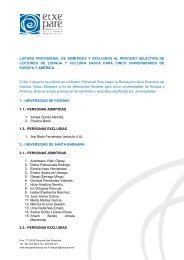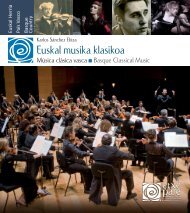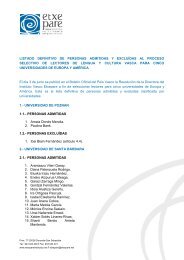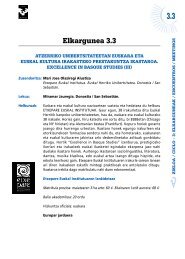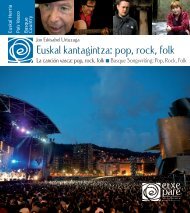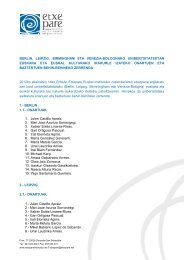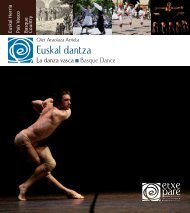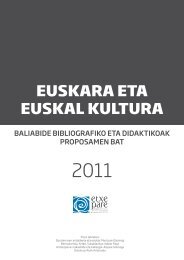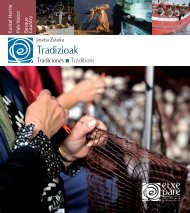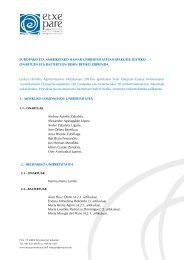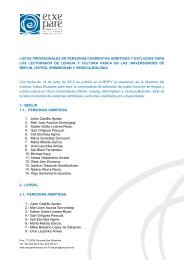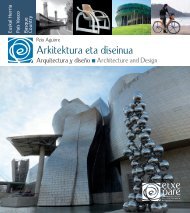XX. mendeko euskal literatura - Etxepare, Euskal Institutua
XX. mendeko euskal literatura - Etxepare, Euskal Institutua
XX. mendeko euskal literatura - Etxepare, Euskal Institutua
You also want an ePaper? Increase the reach of your titles
YUMPU automatically turns print PDFs into web optimized ePapers that Google loves.
Si bien en sus comienzos la <strong>literatura</strong> vasca en euskera<br />
estuvo ligada al mundo eclesiástico y a la educación<br />
religiosa, a partir del siglo XIX la misma tomó<br />
otro rumbo dando la bienvenida a géneros como la<br />
novela (Mitxelena 141). Aunque en dicho siglo sólo<br />
vieron la luz cinco novelas (Lasagabaster 1981: 348),<br />
ello supuso un hito ya que abrió las puertas a otras<br />
tendencias. De todas maneras, hubo que esperar<br />
hasta mediados del siglo <strong>XX</strong> para que la <strong>literatura</strong> en<br />
euskera pasara a ser una actividad autónoma dentro<br />
de la sociedad vasca.<br />
Entre los predecesores de la novela en euskera se encuentra<br />
la obra Peru Abarka de Juan Antonio Mogel<br />
(1745-1804), finalizada en 1802 y publicada en 1880.<br />
Esta obra se basa en el diálogo que mantienen el propio<br />
Peru Abarka y Maisu Juan, y está escrita con un<br />
claro objetivo: convencer a los ilustrados vascófilos<br />
de la pureza y valor del euskera. Cabe reseñar otras<br />
dos obras, Piarres Adame (1888) de Jean Baptiste Elizamburu<br />
(1828-1891), publicada por entregas en las<br />
revistas republicanas La Nivelle y Le Reveil Basque y<br />
en la dirigida por Resurrección María de Azkue Bein<br />
da betiko (1893); así como Ipuin onak (1804) de Bizenta<br />
Mogel (1782-1854), adaptación de las fábulas<br />
de Esopo además de ser el primer trabajo publicado<br />
por una mujer.<br />
En el último tercio del siglo XIX, tras la Segunda Guerra<br />
Carlista, Antonio Cánovas del Castillo suspendió<br />
los fueros. Con anterioridad, varios autores habían<br />
conectado el presente y futuro del euskera a los fueros,<br />
entre otros Juan Ignazio Iztueta (1767-1845),<br />
quien en Guipuzcoaco provinciaren condaira edo<br />
historia (1847) declaró que “Euscara ill esquero Fueroac<br />
ez dira bicico; banan Euscara bici bada, Fueroac<br />
piztuco dira” (si el euskera se muere los fueros no<br />
sobrevivirán; pero si el euskera ha de vivir, los fueros<br />
renacerán) (Madariaga 159). En este sentido, no es<br />
de extrañar que en 1876 emergiera un movimiento<br />
a favor del euskera y la cultura vasca conocido como<br />
Pizkundea, similar al Renaixença catalán y al Rexurdi-<br />
While the origins of Basque literature in Euskara<br />
were linked to the ecclesiastical world and religious<br />
education, from the nineteenth century on it began<br />
to change with the introduction of new genres such<br />
as the novel (Mitxelena 141). Although only five novels<br />
were written in the language during that century<br />
(Lasagabaster 1981: 348), this was still a groundbreaking<br />
development because it paved the way for<br />
other tendencies to emerge. Still, literature in Euskara<br />
did not become an autonomous activity until the<br />
mid-twentieth century.<br />
One of the forerunners of the novel in Euskara was<br />
Peru Abarka by Juan Antonio Mogel (1745-1804),<br />
completed in 1802 yet not published until 1880. This<br />
work is based on a dialogue between Peru Abarka<br />
himself and Maisu Juan, and is written with a clear<br />
goal in mind: to convince enlightened Basque scholars<br />
of the clarity and value of Euskara. Two other<br />
works should also be mentioned: Piarres Adame<br />
(1888) by Jean Baptiste Elizamburu (1828-1891),<br />
published in serial form in the republican journals La<br />
Nivelle and Le Réveil Basque, as well as in Bein da betiko<br />
(1893), edited by Resurrección María de Azkue;<br />
and Ipuin onak (1804) by Bizenta Mogel (1782-1854),<br />
an adaptation of Aesop’s fables and the first work in<br />
Euskara published by a woman.<br />
During the last third of the nineteenth century, following<br />
the Second Carlist War (1873-1876), the<br />
Spanish Prime Minister Antonio Cánovas del Castillo<br />
abolished the fueros (a body of law guaranteeing<br />
regional rights and privileges). Prior to this, numerous<br />
authors had connected the present and future<br />
of Euskara to the fueros. One of them, Juan Ignazio<br />
Iztueta (1767-1845), declared in his Guipuzcoaco<br />
provinciaren condaira edo historia (1847) that, “Euscara<br />
ill esquero Fueroac ez dira bicico; banan Euscara<br />
bici bada, Fueroac piztuco dira” (if Euskara dies, the<br />
fueros will not live; but if Euskara lives, the fueros<br />
will be resurrected) (Madariaga 159). In this regard,<br />
it is hardly surprising that in 1876 a pro-Euskara<br />
9



